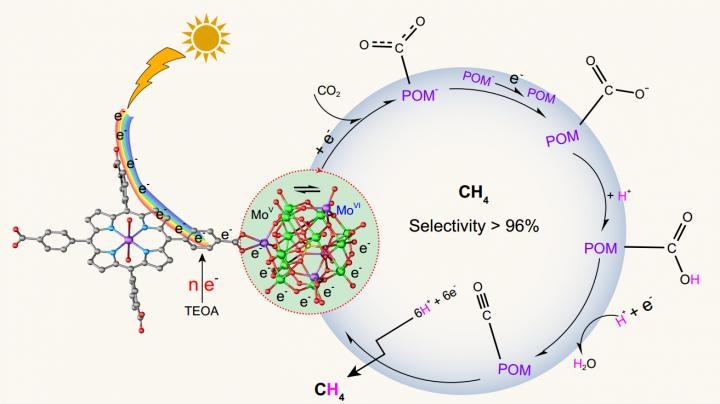Aug 6 2019
Environmental issues and global warming are the results of excessive discharge of CO2 produced from the constant burning of fossil fuels.
 POMCF for converting CO2 into CH4 in photoreduction system (Image credit: Science China Press)
POMCF for converting CO2 into CH4 in photoreduction system (Image credit: Science China Press)
Changing surplus CO2 into a serviceable energy product through artificial methods represents a significant pathway toward sustainable development. A viable method for the above-mentioned conversion is solar-driven photocatalytic reduction of CO2 to carbon-neutral fuels like CH4 and CO and/or value-added chemicals like CH3OH and HCOOH.
By implementing this reaction, the greenhouse effect and also the energy concerns can be reduced concurrently. However, due to the high C=O bond cleavage enthalpy and intrinsically chemical inertness of the CO2 molecule, the structural activation process of this molecule is especially challenging.
Hence, to overcome the extremely negative equilibrium potential (against NHE) for thermodynamically adverse CO2, intermediate, proton-assisted multiple electron reductive products such as chemicals and/or hydrocarbon are usually achieved to reduce the activation energy of the photocatalytic conversion of CO2.
Despite that fact, the creation of high-order electron and proton transferring products still has to overcome a significant kinetic obstacle, and the competitive evolution of H2 further escalates the challenge of achieving the targeted product selectively.
For example, CH4 photosynthesis has posed a major challenge because the achievement of eight-electron transport process needs the photocatalyst to provide both adequate electrons theoretically and potent reducing capability. CH4 is considered the most valuable and desirable hydrocarbon fuel in a photoreaction system.
Scientists perceived that polyoxometalate (POM)-based coordination frameworks, or POMCFs for short, with favorable catalytic performance and familiar structural stability, could be more advantageous to carry out the photocatalytic reduction of CO2 owing to the synergistic effect resulting from the incorporation of MCF and POM.
Specifically, the Zn-ε-Keggin cluster of PMo12 “electron sponges” family, that also includes eight MoV atoms, can act as a powerful reductive component and contribute eight electrons hypothetically.
Four-trapped Zn(II) located in ε-Keggin (PMo12) also forms the Zn-ε-Keggin—a tetrahedral node. When compared to a majority of anionic POMs, the ε-Keggin altered with metal Zn turns out to be a cationic cluster, which is conducive for coordination with organic ligands.
As a result, if the porphyrin derivative and reductive POM cluster can be used to develop POMCF, having the visible-light harvesting as well as photo-excited electron migration, that would serve as an excellent method towards selective photoreduction of CO2 to multi-electron reductive products.
Hence, two POMCFs—NNU-14 and NNU-13—were ultimately developed. These were produced with visible-light responsive TCPP linker and reductive Zn-ε-Keggin cluster. The POMCFs have high photocatalytic CH4 activity and selectivity (greater than 96%) that have considerably exceeded a number of MCF-based photocatalysts.
Hypothetical calculations showed that the photo-generated carriers of CB and VB are largely distributed on Zn-ε-Keggin cluster and TCPP group, respectively. It was observed that the photo-excited electrons flow more easily into the POM port through efficient inter-coupling between the TCPP linker and reductive Zn-ε-Keggin unit.
It was also observed that the introduction of the POM building blocks with strong reducing ability imparts both NNU-14 and NNU-13 with conducive structural rigidity. It also eases the photocatalytic CH4 selectivity by hypothetically delivering sufficient numbers of electrons to achieve the eight-electron reduction of the CO2 molecule.
This viable technique method, organizing potent reducing component into visible-light sensitized photocatalyst architecture, are expected to trigger research enthusiasm towards the development of efficient POMCFs photocatalysts for highly selective reduction of CO2 to CH4 or other similar high-valued hydrocarbons.